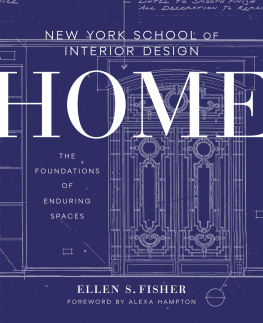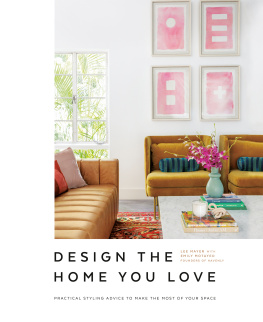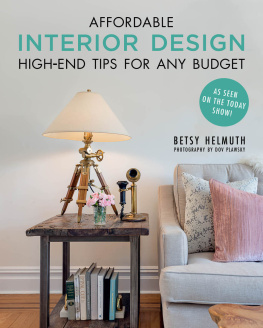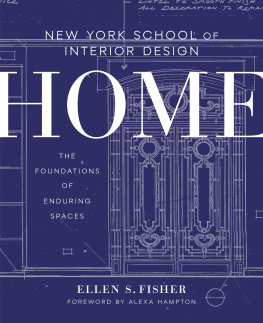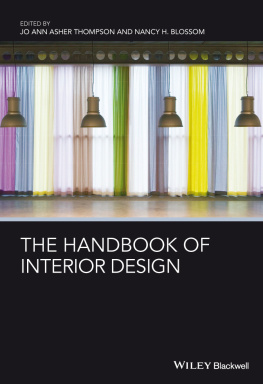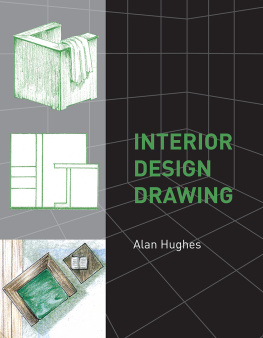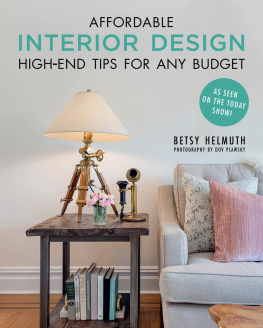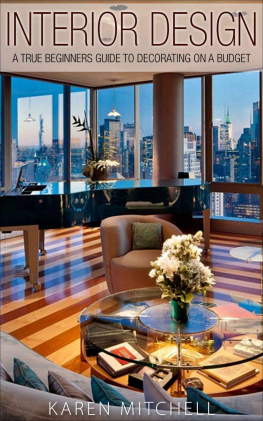ACKNOWLEDGMENTS
We would like to thank the hardworking, talented, and patient team from Clarkson Potter, for giving us the opportunity and support to create this book: associate publisher Doris Cooper, indefatigable editor Angelin Borsics, designers Ian Dingman and Rita Sowins, production supervisor Kim Tyner, production editorial director Mark McCauslin, and former editor Aliza Fogelson, who initially approached NYSID with the concept for Home.
A volume of such length and scope is truly a collaborative effort. We greatly appreciate the invaluable contributions of the following individuals, businesses, and organizations, who shared their deep industry knowledge, allowed us access to their portfolios, projects, and workrooms, and otherwise assisted:
Caleb Anderson
Dean Barger
Neal Beckstedt
Donald Billinkoff
Blanche P. Field LLC
Laura Bohn
Chip Brian
Geoffrey Bradfield
Allison Caccoma
Darryl Carter
CetraRuddy
Coffinier Ku Design
Adrienne Concra
Ellie Cullman
Kati Curtis
Marta Dani
Mercedes Desio
Joan Dineen
Jamie Drake
James Druckman
Pamela Durante
Carol Egan
Thom Filicia
Kristin Fine
Guillaume Gentet
Alexis Givens
Deborah Goldreyer
Judith Gura
Patrick James Hamilton
Bart Hamlin
Alexa Hampton
Addie Havemeyer
Harry Heissmann
Holiday House NYC
Linherr Hollingsworth
Karen Howard
Tamara Hubinsky
Hutker Architects
Ingrao Inc.
J+G Design
Steven Jonas
Jonas Upholstery
Kapito Muller Interiors
Steven R. Kaplan
Lindsey Katalan
John Katimaris
Addison Kelly
Cathy Kincaid
Kips Bay Decorators Showhouse
Terry Kleinberg
Kravet
Laura Krey
Amy Lau
Silvina Leone
Lillian August
Suzanne Lovell
Taruan Mabry
Zack McKown
Gideon Mendelson
Dennis Miller
Richard Mishaan
Benjamin Noriega-Ortiz
Daniella Ohad
Pamela Banker Associates
Amanda Parisi
Charles Pavarini
David Phoenix
Campion Platt
Tracey Winn Pruzan
Elizabeth Pyne
Katie Ridder
James Rixner
Ethel Rompilla
Carlos and Soledad Salgado
Barbara Sallick
Robert Schwartz
David Scott
Mark D. Sikes
Lisa Simkin
Peter J. Sinnott IV
Paul Siskin
Matthew Patrick Smyth
Stefan Steil
Sara Story
Mike Strohl
Alan Tanksley
Phillip Thomas
Calvin Tsao
Alberto Villalobos
Weitzman Halpern
Bunny Williams
Vicente Wolf
Ellen S. Fisher , Ph.D., is the Vice President for Academic Affairs and Dean of the New York School of Interior Design. A member of the faculty since 1999 and a Certified Interior Designer, Fisher maintains a New Yorkarea design practice. She was recognized by DesignIntelligence as one of the 25 Most Admired Design Educators. Ellen Fisher is a professional member of the American Society of Interior Designers (ASID), the International Interior Design Association (IIDA), and the Interior Design Educators Council (IDEC).
Jen Renzi is a freelance writer and a special projects editor at Interior Design magazine. A former senior editor of House & Garden, she has also written, produced, or contributed to more than ten books, including The Furniture Bible, Vera: The Art and Life of an Icon, House Beautifuls Think Small, and Domino: The Book of Decorating. Her work has also appeared in the Wall Street Journal, Architectural Digest, and House Beautiful.
CREDITS
Brett Beyer:
Antoine Bootz:
Jean Bourbon:
Bruce Buck:
Marili Forastieri:
Tony Giammarino:
John Gruen:
Nick Johnson:
Eric Laignel:
Peter Murdock:
Jason Penney:
Eric Piasecki/Otto:
Costas Picadas:
Richard Powers:
Marco Ricca:
Peter Rymwid:
Universal Design Living Laboratory (udll.com)/Mark Leder:
Universal Design Living Laboratory (udll.com)/Scott Cunningham:
Copyright Parish Family, courtesy of the NYSID Archives & Special Collections:
Courtesy of Dufner Heighes:
Courtesy of Kravet:
Courtesy of New York School of Interior Design and Waterhouse Wallhangings:
Courtesy of Terry Kleinberg:
All other photographs copyright 2018 by Mark La Rosa Photography
All other illustrations by Taruan R. Mabry
the
DESIGN
PROCESS
Interior design is a rigorous process built on many decisions. Whether the project in question is new construction or preexisting, a studio apartment or a grand domicile, it requires a methodical, orderly, and organized approach. A specific sequencing of events is necessary to get from concept to completion. Planning ahead, thinking through myriad problems in advance, and sizing up ones needs and spatial constraints to determine the most appropriate and inspired solution are indispensable skills. From day one, every elementfrom the tiniest detail to the most comprehensive architectural modificationneeds to be considered as a whole and managed with informed decision making, scrupulous oversight, and a lot of quick thinking, as things can and will inevitably go awry.
Anyone who takes on a serious design project discovers the unexpected complexity of interior design. Intertwined decisions lead to creative and operational challenges. Even seasoned pros confess that much of their work involves troubleshooting and problem solvingand thats part of the fun. For design enthusiasts of all stripes, the excitement of seeing a vision fulfilled trumps the hiccups that occur along the way.
THE PROFESSIONAL MIND-SET
Most people design their homes in an ad hoc manner, one step at a time: over the course of a few years, they save up enough money or muster the energy to tackle the next room. For instance, a young couple upgrading to a larger abode might use their old furniture plus a few family heirlooms donated by a sympathetic parent to fill the yawning spaces. Months later, as their budget frees up, they buy a few items to plug in the gaping holes. When they become fed up with sitting on a too-small sofa, they buy a new one. Off-the-shelf curtains are upgraded to a custom design; a plain rug is exchanged for a more lush version.
Such a piecemeal approach to interior design can certainly result in a lovely home. But a strategic plan is necessary to achieve the level of finish, resolve, and customization that distinguishes a well-executed space. From information gathering to installation, either the homeowner or a practitioner will need to follow the professional design process as closely as possibleand embrace the professional mind-set:
PLAN AHEAD
Set the vision in advance. Every detail is interrelated, so having the big picture in mind can help you organize and edit as you proceed through the design process. That way, youll know whether to say yes to the quirky lamp you spy on a leisurely Sunday stroll through the flea market. You cannot look at a job through tunnel vision, says designer Vicente Wolf. Everything hinges on something else; its like fitting together pieces of a puzzle.
BE ORGANIZED
Designing a space is a job for a person who relishes bringing order to chaos. Use lists, charts, and spreadsheets, and store it all in three-ring or digital binders. Cross-reference every detail.
EMBRACE TROUBLESHOOTING AS A CREATIVE EXERCISE
Even if you have designed a residential interior before, something will always throw you for a loop, because the system has a million moving parts, and you cant quite know what you are getting yourself into until youre in the middle of it. But for professional designers, troubleshooting is an exciting challenge: instead of doing things the same way over and over again to avoid problems, most prefer to push themselves to find new solutions to enhance a space. Wed go stale if we just did things the same way each time, explains designer Katie Ridder. Part of the challengepart of the artis to figure out how to create something youve never created before.
Next page
